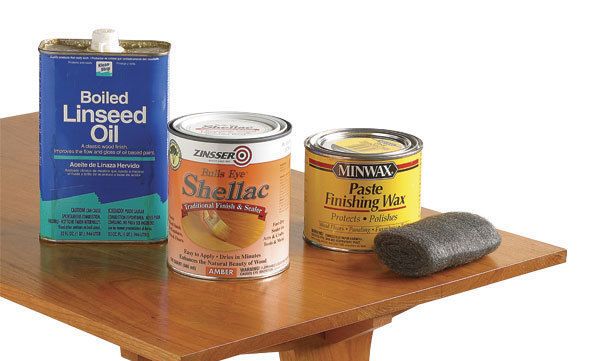
Synopsis: Finishing expert Jeff Jewitt describes this technique as a “down and dirty” French polish. Ideal for a low-build, “in the wood” type of look, this wipe-on finish uses ingredients commonly found in the shop — boiled linseed oil, denatured alcohol, and amber shellac. It takes just a few hours to complete, and you can build the shellac to increase the level of protection. It works so well that we wouldn’t be surprised if it became your favorite finish.
I’ve had to learn to do quick finishing jobs and make fast fixes in my refinishing business. This method is both fast and attractive, whether you’re working on a holiday gift on Christmas Eve or you just prefer no-fuss finishes. I came up with the technique based on necessity, but I’m sure it will save you when time is tight.
This finish is ideal for a low-build, “inthe-wood” type of look, where durability is not the key factor. However, you can build the shellac to increase the level of protection. The ingredients—boiled linseed oil, denatured alcohol, a can of amber shellac, and a few rags—can be found in most woodshops or at the nearest hardware store. The wipe-on technique avoids the hassle of most oil finishes, which can take days to complete. In fact, it works so well that it might become your favorite finish.
A thin coat of oil lays the foundation
For surface preparation, scrape, plane, or sand the wood with the grain to P220-grit. Wipe with naphtha or denatured alcohol to remove dust, dirt, and sanding debris. The solvent will highlight potential problems like glue spots and scratches.
Applying boiled linseed oil is the first step in French polishing, a more tedious and time-consuming technique from which this finish is derived. In fact, you could call this a “down and dirty” French polish.
I’m a big fan of boiled linseed oil for this step, because it contains driers that cause it to cure faster than tung oil. Pour a small amount onto a small cotton cloth. Apply just enough oil to make the wood appear “wetted,” which is about a teaspoon per square foot depending on wood species. Don’t use the “flood on, let sit, then wipe” method. If you do, the oil will seep from figured areas through the thin shellac that is applied in the next step.
Remove excess oil with a clean rag, then lightly buff the surface with a gray synthetic abrasive pad such as 3M ScotchBrite or Mirka Mirlon. The pad will pick up residual oil and will smooth the wood surface further.
Pad on shellac right away
Normally, you would let the oil cure for 24 to 48 hours. You can wait, but if you go directly to the shellac application, it will speed things up and the oil will provide a bit of lubrication for the shellac. The thin coat of oil cures fine below the shellac.
From Fine Woodworking #186
For the full article, download the PDF below:
Fine Woodworking Recommended Products

Odie's Oil

Foam Brushes

Bumblechutes Bee’Nooba Wax






















Log in or create an account to post a comment.
Sign up Log in